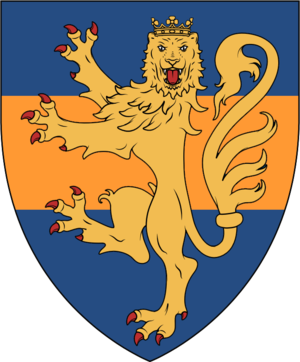Batavian lion: Difference between revisions
(Created page with "thumb|right|The regis batavius leo in the coat of arms of 's Koningenwaarde. The '''Batavian lion''', or '''regis batavius leo''', is a...") |
m (Jonas windsor moved page Regis batavius leo to Batavian lion) |
(No difference)
| |
Revision as of 22:31, 10 July 2020
The Batavian lion, or regis batavius leo, is a mythical lion which became the national animal of Batavia ever since the Battle of Irrel in 1142 AN. It's the modern representation of the Kingdom and can be found in the heraldry of the nation. It's incorporated in the coat of arms of the nations, while several lordships (especially in the Crown Lands surrounding 's Koningenwaarde).
Sign of Cato
The lion was first mentioned as a symbol of unity during the Battle of Irrel (1142 AN), when king Alfons of 's Koningenwaarde had to fight an army of Dietish nobles under the leadership of the Duke of Davignon. The outcome would decide the future of the Batavian Lands: victory would mean unification of the divided lordships, failure would have severely weakened the position of the kingdom of 's Koningenwaarde as regional power.
It's said that the king, Alfons, met a young lion cub while setting up his tent. The cub, an animal which was unknown to the Batavians, was first met with suspicions. The king, however, recognised the animal as a sign and blessing of Cato. He therefore took the lion cub onto the battlefield, where it - according to legend - saved his life by attacking a soldier from his royal guard who tried to backstab him in the heat of the struggle (and was most likely bribed to do so). Alfons, impressed by the courage of the cub, took him home, after valiantly winning a victory against his opponents.
The lion was nurtured within the Kings compound and seen as a member of the family. It is said that the lion grew not only in size, but also in weight: within years he weighed over five hundred kilos. It became evident to the Court that the lion was not a normal beast (even though none of the servants had ever known and seen a real lion).
The lion was never once seen outside the palace premises ever since the battle, and it seemed to have disappeared from Court ever since the death of Alfons I. Legend goes, however, that the lion appears on the inauguration night of every (true) Batavian king or queen's dreams to have a little talk about the Kings of the past.
Most notorious are the nightmares of Leopold II, who already had a fragile mind, in which the lion tried to bite him to death. This was written down extensively in the diaries of his doctor.
A present from overseas?
While the legend is popular among the general population and is sometimes even seen a truth among even the ranks of scholars, some think it more likely that the lion cub ended up in 's Koningenwaarde as a present of the Babkhan shah Babak IV. The Babkhan empire, which at the start of the 12th century enjoyed great economic and cultural growth, had - according to trade scrolls - even made contact with far-away Batavia. What could have lead to the Babkhans granting a lion is unclear.
An old scripture of the Abbey of Kolmar, dating from 1127 AN (predating the Battle of Irrel), mentioned the visit of a Babkhan-looking man with a "noble and divine face", who got impressed by the devout and pious lifestyle of many Koningenwaarders. Some scholars believe the man who was described would later ascend the Babhkan throne and sent the lion cub as thanks to the king for the enjoyable time he had while travelling through the lands.

